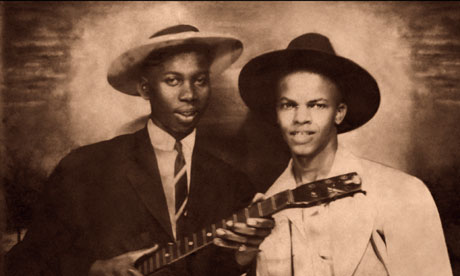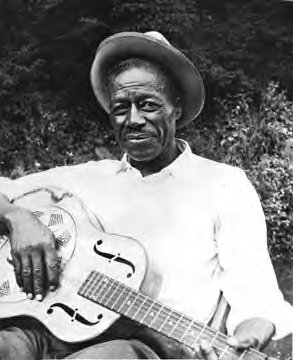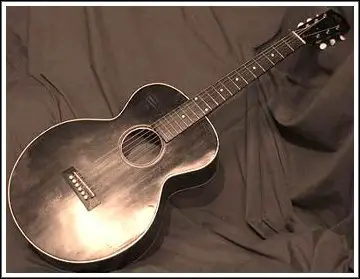How to play Crossroads by Robert Johnson - Crossroads Lesson Preview Video
open G guitar tuning with a bottleneck, or slide.
 Arguably one of the most definitive Delta blues songs, it is basically a version a traditional song, Walkin' Blues, performed by many blues men - notably Muddy Waters, Son House and Robert Johnson.
Arguably one of the most definitive Delta blues songs, it is basically a version a traditional song, Walkin' Blues, performed by many blues men - notably Muddy Waters, Son House and Robert Johnson.
A slide is used to create that plaintive sound and although many have tried, very few have captured that special emotional impact of Johnson's original recording.
Some old school slide guitar players actually use a real bottleneck, but this is mostly for effect and has no real significance except that the old blues guys made use of them. others used a knife of similar to make that eerie sound.
Modern bottlenecks come in a couple of flavors - either glass or metal. For me, the glass type make a warmer sound, and the thickness of the glass wall is important.
A thicker wall means a heavier bottleneck, so when we rapidly move our fretting hand to get that vibrato sound, the heavier slide changes the speed of the vibrato slightly, making for a nicer sound. Just my two cents worth.
The bottleneck technique itself is one of those guitar playing paradoxes.
It's very easy to get the basic action down, but takes a lot more time to control the hand movements so that it sounds nice. If we don't control that bottleneck properly, it turns into a messy sound of glass on metal and isn't very nice to hear, becoming harsh and discordant.
Done properly, however, the technique can produce a warm sounds that just shouts 'delta blues'. Some players make it sound sweet (Johnson, Muddy Waters) and others play it in a powerful, percussive way (Son House).

Accuracy is the key, of course. We need to hit that note, and we don't have a fret to help us, as the bottleneck floats above the frets and doesn't touch them.
Luckily, we can aim for the fret we want and then vibrate the slide until we hit it, which is one of the characteristics of the style.
This is probably one of the reasons why bottleneck blues guitar was so popular in the beginning. In the Delta it was hot and humid and wooden guitars were difficult to keep in tune - it was easier to tune down to open G and easier to hit notes using a slide.
Just remember to damp the strings between the bottleneck and the guitar headstock with a finger. If not, you will hear sounds from the strings both sides of the slide and it'll sound horrible!
Open G is very easy to achieve - the bass E string is brought down to D, the A string to G, and the high E string tuned down to D also - that's it!
Strum it and you have a G chord. Other chords can be formed but they are not really necessary for this song - Johnson uses mostly single strings and half chords, which are fully tabulated in the lesson.
Bringing the Bass E down to D introduces a powerful low bass drone effect and I often use Open D and dropped D for just that reason - it gives a low notes to offset fancy treble work.
AS WITH MOST ROBERT JOHNSON PIECES, ATTACK IS VERY IMPORTANT
What do I mean by attack? Well, for example, you can slide up to a note slow or fast, and also change the speed of the vibrato when you get there.
It all adds to the overall effect. In some cases, when we move on from one note to the next, the change is so fast that there isn't really any vibrato to speak of.
In these cases you need to be very accurate when sliding up to the note. This happens in Crossroads at the beginning of the verses, when we slide up to the 12th fret and then quickly move down to the 3rd fret for a three beat run down, fretting with our finger on two bass strings.
It's a great contrast, playing the low bass run down just after the high treble notes on the 12th fret. It's like a call and answer structure, which has a powerful effect on the emotions of the listener.
Robert Johnson's Bio - A Typical Road Blues Man's Life
Robert Johnson, often hailed as the King of Delta Blues, left an indelible mark on the world of music despite his brief life and limited recordings.
Born in Hazlehurst, Mississippi, in 1911, Johnson's life was marked by hardship and mystery. His music characterized by haunting vocals and masterful slide guitar, encapsulates the essence of Delta blues, a genre that emerged from the Mississippi Delta.
Johnson's recordings from 1936 and 1937, including iconic tracks like "Crossroad Blues" and "Me and the Devil Blues," showcase his unparalleled talent.
These sessions, conducted in makeshift studios, produced 29 songs that continue to influence musicians globally. His music is a cornerstone of blues and has inspired artists such as Bob Dylan, Eric Clapton, and the Rolling Stones.
During his lifetime, Johnson's reach was limited, and he performed mainly in juke joints and on street corners. His friend Willie Brown, along with other contemporaries, played a significant role in shaping his musical journey.
Despite his lack of commercial success, Johnson's posthumous recognition has been immense. The Rock and Roll Hall of Fame describes him as perhaps "the first ever rock star".
Johnson's legend is preserved in various forms, including collections like King of the Delta Blues Singers. His life and music are celebrated in blues museums and through ongoing updates in blues history.
The content of his music, rich with emotion and storytelling, continues to captivate audiences, providing a view into the soul of the Delta blues tradition.
Even if you don#t go for the Devil at the cross road, poor Bob was certainly tortured by something - you can feel it in his music. A typical Johnson blues is jam-packed with emotion, which isn't surprising given the times he lived in. His speciality was a hard-driving road blues, about life, love and death.
More Updates - Jim Bruce Services
It's a great time to be using new technologies and the latest news is you can now find my guitar tuition services on Patreon and access a huge selection of acoustic blues lessons online. Patreon based lesson videos are easy to access in your own time and present everything I know about picking country blues, Delta and ragtime guitar. Check out my pages - See you there!





